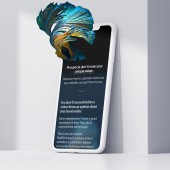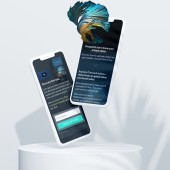
| THE AWARD |
| CATEGORIES |
| REGISTRATION |
| SUBMIT YOUR WORK |
| ENTRY INSTRUCTIONS |
| TERMS & CONDITIONS |
| PUBLICATIONS |
| DATES & FEES |
| METHODOLOGY |
| CONTACT |
| WINNERS |
| PRESS ROOM |
| GET INVOLVED |
| DESIGN PRIZE |
| DESIGN STORE |
| THE AWARD | JURY | CATEGORIES | REGISTRATION | PRESS | WINNERS | PUBLICATIONS | ENTRY INSTRUCTIONS |
Builtforimpact Website by Zlatina Petrova |
Home > Winners > Design #86089 >Interview |
 |
|
FS: What is the main principle, idea and inspiration behind your design?
ZP: To demonstrate the BuiltForImpact system itself, and how the Mission Narrative structure can enable a company to empathize with a visitor's problem online rather than merely bask in its own majesty.
FS: What has been your main focus in designing this work? Especially what did you want to achieve?
ZP: We want to make our target audience feel understood, before making them understand. We want them to understand that standing out is difficult, selling better feels confusing, and making a difference is a noble goal. Lastly, we want our audience to see that we've made their problem our problem and that we'll start solving it for them at no cost to them.
FS: What are your future plans for this award winning design?
ZP: The design has a responsibility to represent the system, and so it will continue to evolve as the needs of our audience change and the systems we've developed are refined by the needs of the market. We'll also continue to interview and learn from the greatest minds in marketing and social entrepreneurship, to ensure the system always remains the best option in the world for those it was designed for.
FS: How long did it take you to design this particular concept?
ZP: The BuiltForImpact system was designed over the course of 12 months, though the learning required that led to the opportunity to build such a system took many years. The BuiltForImpact website is a representation of that work and the work that is still to come.
FS: Why did you design this particular concept? Was this design commissioned or did you decide to pursuit an inspiration?
ZP: There are no more mass markets. Consumers want to support businesses with a cause. Most marketing maps and strategies weren’t drawn for businesses with a cause. This one was. Because our team's goal is to "help difference makers make a difference", we saw it as our responsibility to create this system and reserve it for those using the market to make an impact.
FS: Is your design being produced or used by another company, or do you plan to sell or lease the production rights or do you intent to produce your work yourself?
ZP: We produce the work ourselves in collaboration with those we serve in the market. The system itself is something we train people on all the time so that they can either elect to implement it themselves or work with us to get everything implemented.
FS: What made you design this particular type of work?
ZP: It became apparent to us that cause-driven companies are this era's vehicle for change. It used to be philosophers and preachers, now it's the marketplace. Conventional businesses typically out-sell and out-think their charitable or sustainable counterparts, partly due to having better communication strategies. So the BuiltForImpact system was designed to be a blueprint for solving that problem, matching the rising consumer desire to buy ethical/sustainable or social good products and services.
FS: Where there any other designs and/or designers that helped the influence the design of your work?
ZP: Through interviews, courses, research and books, we consulted leading marketing minds and cause-driven companies, then organized and distilled our learnings into a single, unified system. None of the base components of the system are "new", rather, they are reconciliation and consolidation of leading ideas, so that those we serve can benefit from that work at a fraction of the time, cost, or understanding.
FS: Who is the target customer for his design?
ZP: Companies that exist for reasons beyond the dollar alone. Cause-driven, sustainable, ethical, triple-bottom-line, social-good, B-Corp, or charitable organizations.
FS: What sets this design apart from other similar or resembling concepts?
ZP: It does things in a completely different way. Most websites are designed based on what's cool, or what the designer is into at the time, or what that year's trends are. Most copy is written based on what an internal committee would like to say about itself. Conversely, our system is designed to say what the audience wants to hear and is designed to express that message.
FS: How did you come up with the name for this design? What does it mean?
ZP: It came from the conversation: we found ourselves saying "their websites should be built to make an impact" and phrases like it. As such, "BuiltForImpact" became the name as a representation of the intent behind the system: "This website was BuiltForImpact."
FS: Which design tools did you use when you were working on this project?
ZP: Adobe Photoshop, Adobe Illustrator, Adobe Premiere Pro, Adobe After Effects, Sketch, Principle.
FS: What is the most unique aspect of your design?
ZP: That the entire narrative is based on the intended reader, instead of on itself. The visuals represent emotions the intended reader is experiencing, rather than on shoving our work down their throats.
FS: Who did you collaborate with for this design? Did you work with people with technical / specialized skills?
ZP: This system–and the site that represents it–was created in-house by the Fairhead Creative team. Skills included: marketing strategy, copywriting, visual design, illustration, animation, audio production, video editing, front-end web development, back-end web development.
FS: What is the role of technology in this particular design?
ZP: Technology is a quarter of the implementation: Strategy, Copy, Design, Development. In order to permit liberal creative and empathic expression, the technology must be able to bring designs to life that weren't made under technical restraints.
FS: Is your design influenced by data or analytical research in any way? What kind of research did you conduct for making this design?
ZP: The design is influenced heavily by our ongoing research. Its job is to bring a message to life, and the way we do that is by listening to those the site is for. Every time we use this system, we spend hours with those it is created for, coaching through a series of probing and mind-expanding questions about audience, service, fear, goals, and mission.
FS: What are some of the challenges you faced during the design/realization of your concept?
ZP: The message is largely emotional, rather than simply displaying physical product shots or portfolio pieces. As such, the design needs to use visual metaphors to articulate its meaning–metaphors that our intended audience will understand and relate to.
FS: How did you decide to submit your design to an international design competition?
ZP: We're lucky people to have positive feedback from the companies we serve. We decided to submit the "BuiltForImpact" system in an international design competition because we also want to see the feedback from our community- the design community. For our team, this is a way to evaluate our work and design decisions.
FS: What did you learn or how did you improve yourself during the designing of this work?
ZP: Every time we work on this system, we learn more about those we wish to serve. We learn about metaphors and messages they relate to. We learn about how we could improve the varying facets of the system. In short, we improve ourselves because we understand our market even more intimately.
FS: Any other things you would like to cover that have not been covered in these questions?
ZP: With design, if "success" is your goal, it's unlikely to be achieved. At Fairhead Creative, we’d like to argue that “success” is a starting point, not a finishing line. An ingredient, not a destination. Success: Trying until you reach a goal in the short/medium/long term. Unwaveringly, with commitment. Failure: Stopping that trying process prior to goal attainment. Giving up and going home. If we try, then stop trying, that’s a failure. If we continue to learn and iterate, then achieve the goal, that’s a success. Great design with a heart for service is never over. Just like this design, it will continue long into the future, as an act of service to those we wish to serve. To us, that's the success.
FS: Thank you for providing us with this opportunity to interview you.
A' Design Award and Competitions grants rights to press members and bloggers to use parts of this interview. This interview is provided as it is; DesignPRWire and A' Design Award and Competitions cannot be held responsible for the answers given by participating designers.
| SOCIAL |
| + Add to Likes / Favorites | Send to My Email | Comment | View Press-Release |




